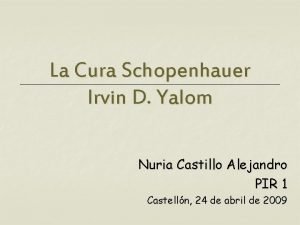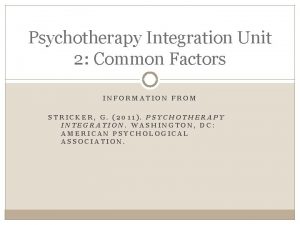Curative Factors of Group Psychotherapy Yalom Curative Factors









- Slides: 9

Curative Factors of Group Psychotherapy Yalom

Curative Factors The imparting of information The instillation of hope Universality Altruism The corrective recapitulation of the primary family group

The developing of socialising techniques Imitative behaviour Interpersonal learning Group cohesion Catharsis

The development of the ability to identify and put to therapeutic advantage maladaptive interpersonal behaviour as seen in the social microcosm of the small group is one of the chief tasks of a training programme for group psychotherapists (Yalom)

The key to change as a result of group psychotherapy is that the individual is able to gain insight into how others see them, into what they are doing to and with other people, into why they do what they do and finally how they got to be the way they are. (Yalom)

Role of the Group Psychotherapist To help the group to develop into a cohesive unit To assist in the development of therapeutic group norms To be a technical expert – shows the group how to interact, how to start the process

The therapist needs to develop methods to help patients to disclose, to express themselves honestly The therapist must keep the group at work The therapist makes interpretations which assist the patient to gain insight into their behaviour The therapist is a role model

The therapist may help to identify and classify the patients’ interpersonal behaviour, their parataxic distortions relates (this relates to when one person relates to another not on the basis of their real attributes but on the basis of a personification chiefly existing in fantasy) and their interpersonal impact on one another.

When patients have recognised the rigidity, the defensiveness, the maladaptive self-defeating quality of their behaviour therapist turns his attention to the why. (Yalom)

















